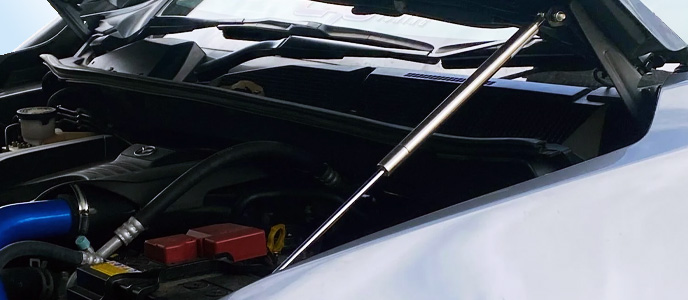27 March 2023
![How to Know When It's Time to Replace Your Vehicle's Gas Strut]()

Gas struts, also known as gas springs or gas stays, play an important role in the smooth operation of various parts of a vehicle, including the bonnet, boot, some windows, and pop-tops. Over time, these gas struts gradually lose pressure and will eventually be unable to support the load of the component they are designed to support. Here are some ways to know when it's time to replace your vehicle's gas strut.
Signs to look out for include:
Difficulty in opening the boot or bonnet
One of the most common signs of a failing gas strut is difficulty opening the component. If you notice that it takes more effort to lift or lower the bonnet or boot, or if they don't stay open or closed, it may be a sign that the gas strut is losing pressure and needs to be replaced.
Squeaking or hissing noises
Gas struts work by using compressed gas to create force. Over time, the seals in the strut can deteriorate, allowing gas to escape, and causing a hissing noise. Additionally, worn-out struts may produce a squeaking or creaking sound when opening or closing the doors or trunk. These noises are indications that the gas strut may need to be replaced.
Visible signs of wear or damage
Take a close look at your gas struts for any visible signs of wear or damage. Check for cracks, leaks, or dents in the strut body or mounting brackets. If you notice any signs of damage, it's time to replace the gas strut.
It's important to note that gas struts generally have a lifespan of 5-10 years. The action on most car-fitted gas springs is subtle enough that many drivers don’t realize they’re actually helping to raise the tailgate, as opposed to just holding it in place once it’s up. However, it’s easy to tell how much heavy lifting these fixtures do once they start to wear and degrade - especially with some hatchback rear doors, which can feel remarkably heavy if their gas struts are overdue for replacement.
Some areas of your vehicle that use gas struts:
Bonnet Gas Strut
Gas struts are commonly used to support the weight of a vehicle's bonnet or hood when opened. If you notice that the bonnet is difficult to lift or doesn't stay open, it may be a sign that the gas strut needs to be replaced. Over time, gas struts lose pressure and will no longer be able to hold the bonnet open, causing it to fall or close unexpectedly.
Boot Gas Strut
The most common usage of gas struts in vehicles is in boot-lifting mechanisms. Nearly all hatchbacks and wagons have gas struts affixed to the rear assembly, helping to lift, support, and lower their heavy tailgates smoothly and effortlessly. If you notice that the boot is difficult to lift or doesn't stay open, it may be a sign that the gas strut needs to be replaced.
Window Gas Strut
Gas struts are also used in some vehicles to support the weight of the windows when opened.
Pop-Top Gas Strut
Gas struts are also used in some types of recreational vehicles (RVs) and troopys to support the pop-top or roof. Pop-top gas struts help to keep the roof in an upright position when opened, allowing for additional headroom and ventilation.
Ovesco does not recommend regassing old struts, as it can be dangerous. For safety reasons, gas struts should be replaced entirely. Regular maintenance and inspection of gas struts can help identify any signs of wear or damage, ensuring they are replaced before they fail.
In summary, gas struts are essential components in the smooth operation of various parts of a vehicle, and it's important to identify when they need to be replaced. Regular inspection and maintenance can help prevent unexpected failures and ensure safety while using your vehicle. If you notice any of the signs mentioned above, it's recommended to replace your gas strut to avoid any potential safety hazards.




